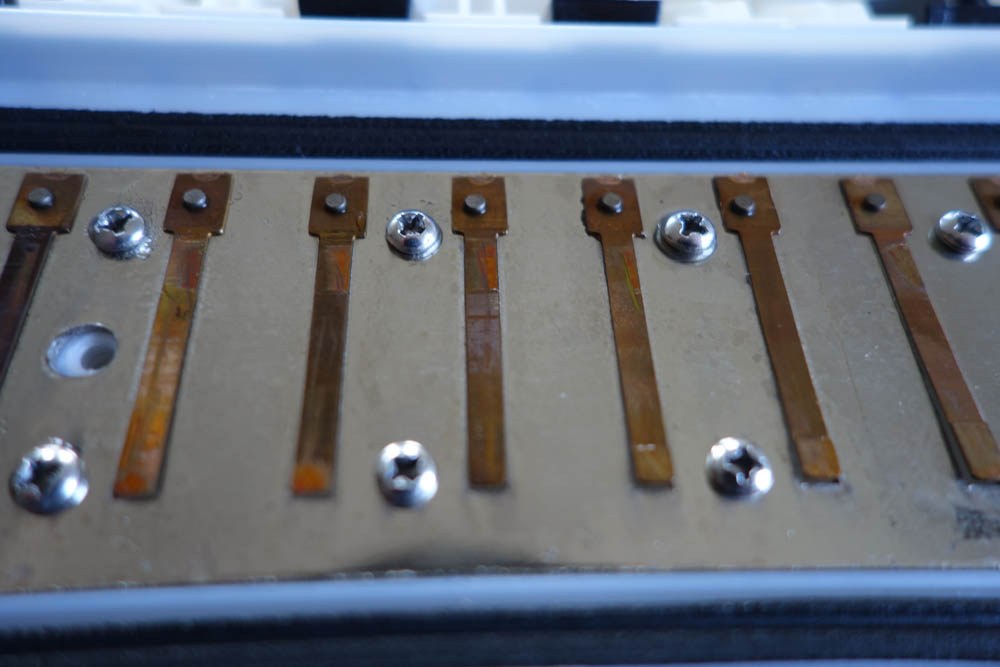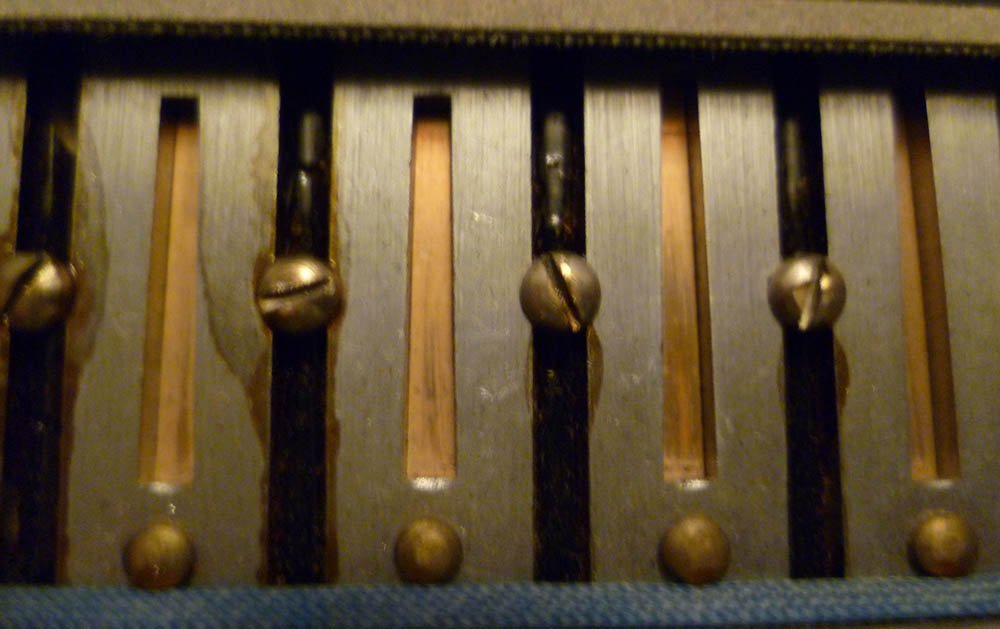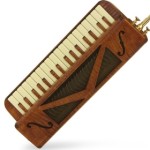Melodica reeds – harmonica or accordion style?
- This topic has 25 replies, 8 voices, and was last updated 8 years ago by
 Melodica-Me.
Melodica-Me.
-
AuthorPosts
-
March 18, 2015 at 12:16 am #4396
 DarenKeymaster
DarenKeymasterIt seems that the most coveted reeds in any melodica are the ‘single’ style accordion reeds. You’ll find them in all the high end instruments, Vibrandoneons, Eolinas, Vintage Hohner Pro 36s, Claviettas etc. Most players who don’t have an instrument made with them, wish they did, and we all seem to hark back to the golden era when melodicas were built with love, care, and a full set of accordion reeds!
Harmonica-style melodica reeds:

Accordion-style melodica reeds:

I’m lucky enough to own a lot of these high end melodicas, and I agree that they can sound good. But I also play much cheaper melodicas, like the Yamaha Pianica, and Suzuki models. I’ve sometimes asked friends which they prefer, and they nearly always point to the Vibrandoneon, claiming that it sounds professional and warm. But when I invite them to do a blind test, where they can’t see the instrument, it’s often one of the cheaper plastic models that wins.
This makes me wonder to what extent looks play a role in how we perceive sound. It’s all too easy to imagine that because a melodica is made out of beautiful wood, and expensive Italian parts, it also makes a beautiful sound. But is it a case of the emperor’s clothes?
Personally I prefer my Yamaha Pianica over my Vibrandoneon. This is for several reasons. I prefer the light weight and size of the Yamaha. I appreciate how easy it is to maintain, and that it has no mould or technical issues. But what I most prefer is its harmonica-style reeds. I find them easier to play (they take less air), and more responsive and expressive. I find the whole experience more fun.
One thing I do like about accordian-style reeds, is that the general tone seems to have a weight and solidity. The tone is stable and unchanging as you play a long note. This can really suit some genres such as classical, or that French circus/Yann Tiersen sound. And there are some drawbacks to harmonica style reeds – in my experience, they’re not as stable, they need tuning more often, and they occasionally break. But violins need tuning several times during a performance, and their strings break!
What do others think? Do you prefer expensive accordion-style reeds over cheap harmonica-style reeds? If so, what exactly is it about them you like? I’d love to know!
March 18, 2015 at 1:34 am #4398 Adam TombsParticipant
Adam TombsParticipantGreat topic! I think that a well made harmonica style reed melodica plays very well. I have long been a fan of my older model Hohner Piano 36, it has harmonica reed but is still a very good instrument. I also like quite a few of the older suzuki and hohner models that all have harmonica reeds.
At the same time I only have experience of one accordian style reeded melodica, my Hohner Professional 36. It truly is a wonderful instrument with a different sound. It’s harder to play and requires more air than any of my other melodicas, not an impossibly large amount of air but it is a noticeably higher air requirement. I note that i refer to accordion ‘style’ reeds rather than just saying that they are accordion reeds, having an accordion repairer match an accordion reed to my Professional 36, it was obvious that there is a lot of difference between those in the pro 36 and the accordion reeds.
I had thought, as I am far from a competent keyboard player, that it might have something to do with the ability of the musician who plays the two different types. It would seem certainly that amongst the more accomplished keyboard players and professional musicians on this forum, that it might come down to a personal preference and the style of music being played. Personally, I don’t have a preference, however I do get a lot of enjoyment from repairing the older models and making them playable again, while I will always have a reliable newer model to just pick up and play around with.
March 18, 2015 at 7:07 am #4404Johan Pieterse
ParticipantPersonally I love the stable sound of the melodicas with accordion reeds, however for economical reasons I also have a melodica with harmonica style reeds. I would like it if manufacturers can also experiment with the body type and sound channeling in the melodica to get a more accordion-like sound out of the instrument. I also do agree that a good player can get quite far even with good harmonica reeds.
March 18, 2015 at 8:09 pm #4406 QuetscherParticipant
QuetscherParticipantFirst of all we should clear terms: are we talking about accordion or harmonica style reed plates (i.e. single or multi reed plates) or are we talking about accordion or harmonica style reeds (i.e. thicker reeds possibly made of stainless steel or thinner reeds made of brass)?
This seems quite important to me because as far as I know the reed plates don’t influence the sound much. So what are single reed plates good for? Can you change them more quickly if a reed has been damaged? If they are screwed yes, but mostly they are glued with wax, so you can’t change them that simply. So what’s the point of waxing?
The technique comes from the accordion where you want to avoid wear and tear from screwing into the (wooden) reed block. The reed block is made like a series of small chambers. On the one end you have the valve, on the other end you have the reed plate which you glue with wax it to seal this side of the chamber completely. So maybe single reed plates for melodicas are just a residual of this accordion technique which is redundant for plastic or metal melodicas (just remember who uses or used single reed plates: accordion manufacturers like Hohner, Victoria, Ballone Burini and the manufacturers of accordinas).
So, the crucial point for me seems to be the reeds themselves as the base of the sound. Like Johan I prefer the accordion style reeds because I like a stable sound over a wide dynamic range. (And like Johan I have got the feeling that the sound depends as much on the reeds as on the body material and the sound channeling inside of the melodica. It would be very interesting to compare the sound of different reeds in one and the same instrument or even outside of a melodica!)
BTW, Daren, I’m not sure if your impression that the Vibrandoneon is harder to play than other melodicas comes from the reeds themselves. Those are highest quality reeds, and when you play them in an accordion it is a dramatic difference in response and dynamics in comparison with mid or even higher class reeds. I suspect that it is the bigger air chamber that makes it harder to play although on the other hand this may create a bigger, rounder sound.
A little story about “The emperor’s new clothes”: I went to a brass manufacturer yesterday to make him create a new tube for my Vibrandoneon. A friend of his was there, too, and he asked me to show the instrument to them. There was a great “Wow!” – and they didn’t mean the sound but the looks of the Vibrandoneon, they weren’t even interested in the sound.March 18, 2015 at 10:32 pm #4407 DarenKeymaster
DarenKeymasterJohan – I’d also like to see some experimentation on how to achieve a good sound, it seems that there just hasn’t been much research
Adam – I also find the my Hohner Pro 36 takes more breath to make a sound. This is interesting, as it has quite a small air chamber. Does this mean that it’s the actual reeds that are hard to blow through?
Quetscher – ok, let’s say harmonica-style reeds are lots of thin bronze (or occasionally stainless steel) tongues on a long plate, and an accordion style reed is a single thicker steel tongue on an individual aluminium plate.
So yes, it could be the large air chamber of the Vibrandoneon that I’m not keen on. It means that the air from my lungs has a long journey to travel before meeting the reeds. Whereas I like to be as close to the reeds as possible. I find this gives me a greater degree of control. I did try putting Vibrandoneon reeds in a Yamaha Pianica once, but found that there wasn’t much difference in the sound!
Maybe it’s the thin tongues that I like. Could they respond faster to the breath, in comparison to reeds designed to be used with bellows?
Like you, I also prefer the tone of accordion reeds, but harmonica reeds seem to me to have the larger dynamic range. They sound at the smallest whisper, and then provide a lot of volume when blowing hard. But they never have the fullness of tone of an accordion reed.
I would really like a combination of the two! I think we really need some special reeds designed for the melodica. They need to have a full and stable tone, but also be light enough to respond easily to the human breath.
March 19, 2015 at 2:06 am #4408 Adam TombsParticipant
Adam TombsParticipantDaren – I think that the thickness and material used to make the reeds in the pro 36 is what makes it require a little more air. Thicker, less flexible, requiring more air to make the reed move as opposed to thinner and more flexible reeds that require less air to get them to move….
Interestingly enough, my one true accordion reed that was used to repair the broken original Hohner Pro 36 reed requires slightly more air than the stock ones to get it to move but is also more sensitive to over blowing. Tone is excellent and stable, volume appears to be ever so slightly less. Bearing in mind that this is a modified true accordion reed and not an accordion style reed as discussed above.
March 19, 2015 at 4:37 am #4410 Melodica-MeParticipant
Melodica-MeParticipantGreat topic Daren, I personally prefer the sound of accordion reed than harmonica reed plates but I do agree that the harmonica reeds plates do provide better air chambers. The Hohner Pro 36 has a good chamber but if you have a small leak it can drain the air right out if not found and sealed. The Solist has a much tighter air chamber than the Pro 36, which makes it a louder melodica, even though the reeds seem to be the same… For over a year I have hoped that the plastic version of the Vibrandoneon would have been released, since Ballone Burini advertises that it would have accordion style reeds as the original Eolina or Vibrandoneon. Being plastic I would assume that the air chamber would be tighter with rubber seal possibly. No dought in my mind that BB would create a great sounding blow accordion as they did with the Eolina and Victoria with the original Vibrandoneon. Replacing a single reed over replacing a reed plate because as the saying goes “one bad apple” has put a bad taste in my mouth if you know what I mean. If and when the new Vibrandoneon is released I do hope that reeds will be readly available to the consumer at a reasonable cost. I recently paid approx. $75 for a reed plate set for my Hammond 44, I can imagine what a set of reeds would cost for the Vibrandoneon. In the case of the Clavietta the biggest issue with its single reeds is volume. If you remove the metal body over the reeds, it is definately louder but the sound is thin with no resonace afforded. In my opinion with all that is given above the Pro-36 is the best alternative for a single reed melodica for most as long as you can get one slight to no leaks.
Melodica-Me
Monsters of Melodica.March 19, 2015 at 11:10 am #4412 QuetscherParticipant
QuetscherParticipantDidn’t we have an italian accordion maker whose uncle was a reed designer here at the forum? As far as as I remember he offered help with melodica reeds – maybe it’s time to call him up and ask him if he’d design some mixture between accordion and harmonica style reeds?!? I’m sorry I don’t remember his name and I didn’t find the right thread.
March 19, 2015 at 2:31 pm #4418 DarenKeymaster
DarenKeymasterQuetscher, yes we did, he commented on my blog, but then vanished!
Adam, that’s really interesting. When I put Vibrandoneon reeds into a Pianica, I also found that they were much more sensitive to overblowing
MM, a winning formula could be single reeds with a small air chamber? I’m also fond of the Pro 36. Great tone and action. It’s weakness seems to be that it’s not that loud, (though nowhere near as quiet as the Clavietta), and that it suffers from an overly complicated design which is prone to leaks, and extremely difficult to repair. Yes, looking forward to the new Vibrandoneon. They could probably make it quite a bit smaller than the last model
March 19, 2015 at 9:15 pm #4431 DarenKeymaster
DarenKeymasterMM, what are the negs about the Pro36?
March 19, 2015 at 9:54 pm #4437 Melodica-MeParticipant
Melodica-MeParticipantGood question Daren, There are a couple, weight would be the big one. If you play in a downward position it is not bad, but if you play in a trumpet position you will start to feel the weight quickly. Compared to the Piano-36 its a tank. If you own the version with the moisture release button, you can’t get all of the moisture out (it has a filter at the hole). The version with the screw cap like Bruno’s is much better, remove the cap and blow hard and a good amount of moisture will come out. The button is faster but not as effective as the screw cap version. I like to unscrew the cap, place the melodica on its stand put a towel under it and let the moisture fall out by gravity at the end of practice. The Solist has the button too of which I do not like so I tend to clear often. I have compared (2) pro-36 with the Solist and the Solist is by far louder than the Pro-36. I have one Pro-36 with no issues at all, no leaks nada almost perfect, and one with a very tiny leak at a key pad, the volume is at least 10-15% lower between the (2) Pro-36, so a larger leak can rally cause issues. And as you noted earlier on another post it is a complicated melodica to work on. I think the easiest melodica with single reeds to work on is the Clavietta.
Melodica-MeMarch 20, 2015 at 4:18 pm #4446 DarenKeymaster
DarenKeymasterYes, I own the capped version as well. I took mine apart about 10 minutes after it arrived, to see how it was put together, and it’s been so difficult to put together again, I haven’t been able to play it again 🙂
I bought it specifically to compare it the Yamaha P37, to see how the sound of the accordion reeds compared to the (possibly best of the) harmonica reeds. You can probably guess, I preferred the Yamaha reeds!!
March 20, 2015 at 6:56 pm #4447 Melodica-MeParticipant
Melodica-MeParticipantOh No, thats not good, your Pro-36 looked perfect. I took my Pro 36 to the person who repair by Vibrandoneon. He said that the Pro 36 is a time consumer but not an issue to repair. I like working on them but I leave the hard to fix leaks to them. It cost me $75.00 USD to put new seals/pads where needed and to plug any leaks, tune (all) reeds and clean my Pro-36. a couple of years ago. I don’t own the Yamaha P37 but I may have to get one just to see how it plays and sounds.
By the way you did you buy the button Eolina on Ebay ???? 🙂
March 24, 2015 at 11:13 am #4472 DarenKeymaster
DarenKeymasterNo, it wasn’t me!
Sounds like you’ve a got a good repair man 🙂 I’d definitely like to see what you think of the Yamamha compared to other models…
March 29, 2015 at 9:18 pm #4540 OfirParticipant
OfirParticipant+1 for Daren’s last comment
-
AuthorPosts
- You must be logged in to reply to this topic.
